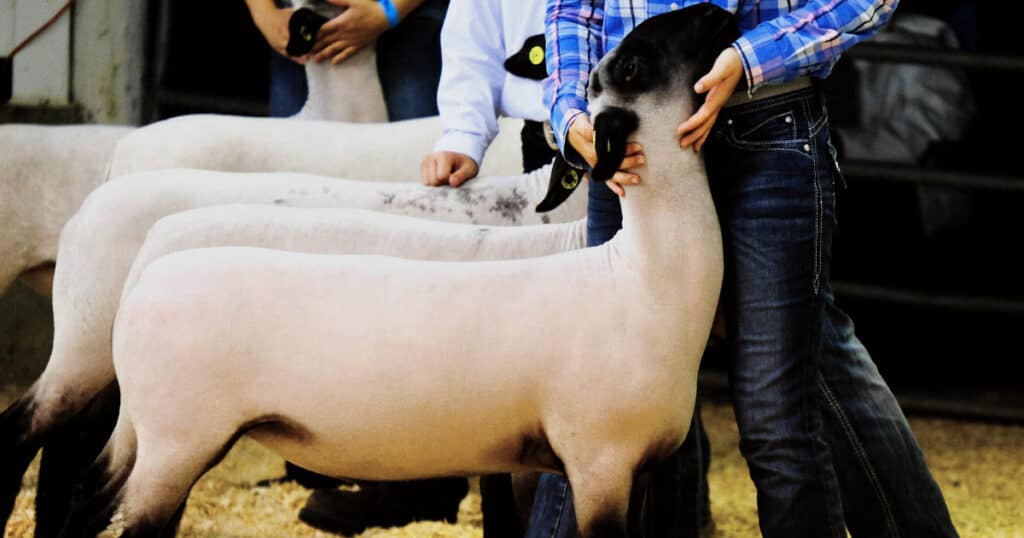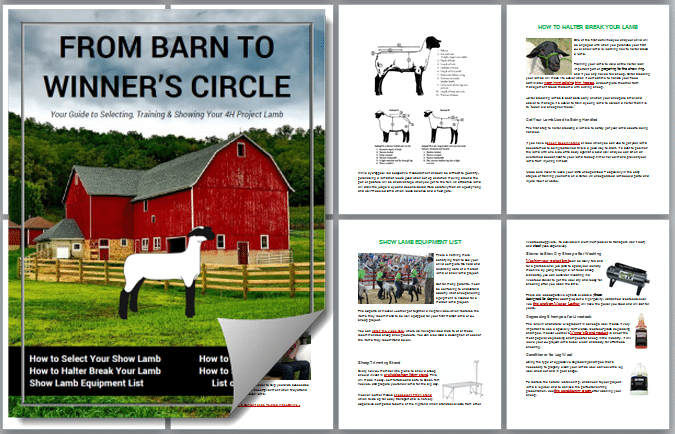If you’re looking for a good guide with sheep showing tips, you aren’t alone. Whether you’re just getting started with sheep or are an experienced showman looking to take your craft to the next level, this article can help by providing simple guidance on how to show sheep and links from other resources to help you enjoy success in the show ring.
While there are regional differences when it comes to showing sheep, some general principles such as your positioning and the position of your show lamb or yearling will hold true anywhere.
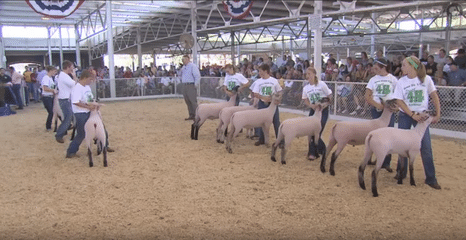
These basic sheep showing tips which can be universally applied are where we will begin.
Get Your FREE 4-H Lamb Guide
From Barn to Winner’s Circle is a 30-page PDF packed with our best tips to take you from buying your first lamb to placing at the top of your showmanship class.
Start with a Sheep Show Schedule
One of the first, and often overlooked steps to preparing for a successful sheep show is ensuring that you’re well prepared.
Know the date and time of your show, and schedule adequate time for washing your sheep, trimming your sheep, and ensure you have an hour or so free before the show begins to make final touch-ups and preparations.
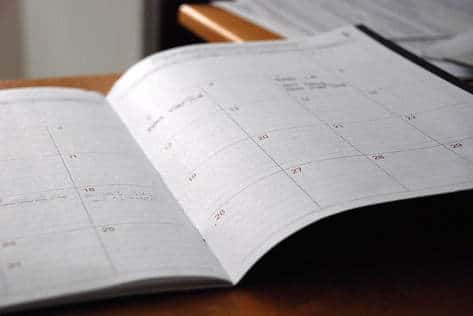
For a 4H market lamb or show lamb project, choose a day 2-3 weeks before the show to do a rough shearing of the lamb. This will make your lamb easy to wash and slick shear on your trimming stand when you get to the fairgrounds, helping them appear cleaner, fresher, and more attractive in the show ring. That final hour before the show will be spent applying a good hide conditioner, brushing out your lamb, and using a slicker brush on the lamb’s legs to remove any bedding or debris from the pen.
For a breed class, your preparation will vary depending upon the breed of sheep you are exhibiting.
If you are showing a meat breed like a Hampshire, I recommend “cutting out” your lamb or yearling about 30 days prior to the show, taking the wool down to nearly slick sheared in most places on the sheep’s torso and sides. This gives your sheep adequate time to regrow some wool, but it saves you time when you get to the fair and wash your sheep, shear the animal’s belly and neck with electric sheep shears, and to do the final trimming with hand shears. Expect to curry, card, and do finish trimming several times during the days leading up to the show to achieve a smooth, firm finish on the wool. The last hour before the show can be spent using a slicker brush on the sheep’s legs and head, and to provide any light carding and trimming to touch-up your sheep for the breed class.
If you are showing a wool breed like a Romney, I recommend shearing the belly of your sheep about 2 weeks before the show. This will give the sheep a cleaner, taller appearance in the show ring, but allows for the wool to regain its natural coloration from the environment for a more natural appearance. Blocking can be done in one or two passes prior to the day of the show, and light currying of the animal’s legs and head prior to entering the ring is sufficient final preparation, as most wool breeds are shown without washing so the sheep’s natural wool can be evaluated.
For any sheep entering the show ring, cleanliness is important. Take a few minutes before your class is called to enter the ring to wipe down the animal’s eyes, nose, ears, and any other areas which may have accumulated dirt or debris.
Train Your Sheep for Showing Beforehand
Most beginners choose to halter break their lambs and show their lambs on a sheep halter. This takes time, and it’s easiest if done well in advance of show-day. Even if you are more advanced and plan to show your sheep without a halter, practice leading it around so it walks with a natural gait and looks its best when on the move in the show ring.
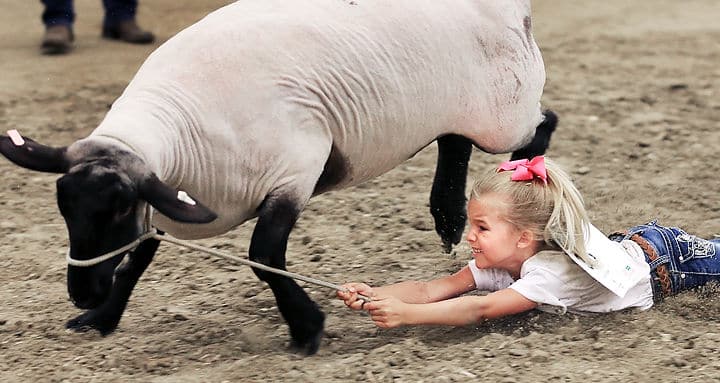
Preparing your lamb for exhibition involves more than training it on a lead. You should practice setting your sheep’s feet in the proper “Set Up” position to get your lamb used to bracing, and having their legs touched and re-positioned. The last thing you want is for your lamb to spook in the ring and to take you for a ride (or worse, escape!).
Your Appearance Matters Too
Some sheep shows have a specific dress code which they require for 4H or general sheep show exhibitors, but even if you are showing your sheep in a ring without a required dress code, you should take steps to present a clean, professional appearance. Tuck in your shirt and wear a belt. Don’t wear a baseball hat, and make sure that your clothes fit well, are clean and in good repair.
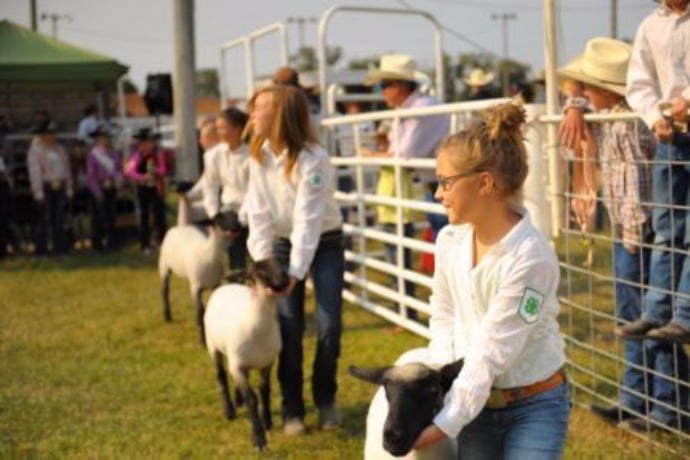
If you are wearing your hair up and using a halter, consider coordinating your bow or hair tie with the color of your lamb’s halter to help attract the judge’s eye. Attention to small details like this can help you stand out and can affect how much time the judge spends evaluating you and your animal.
Be On Time (but not too early)
It’s important not to be late to your sheep show class, but getting your animal to ringside too early should also be avoided. Not only will this make the entrance to the show ring congested, but if you stand around with your show lamb for too long waiting for your class, your animal can tire. This can either make the animal difficult to handle when you finally enter the ring, or your lamb could get sleepy, which will make it look less than its best when you enter the ring.
If you aren’t the first show class of the day, look at the show order, watch a few classes to get a sense for how long they’re taking, and try to be ready to enter the ring about 5 minutes before your class is called.
Pay Attention to the Judge
It’s important to maintain good eye contact with the judge of your class at a sheep show, and to be aware of his or her position in the ring, and the directions the judge is providing to showmen. It’s easy (especially at your first sheep show) to become preoccupied with getting your sheep set up and positioned correctly and to forget that the judge will be moving around the ring and directing you to move your sheep and eventually place the class in the correct order.
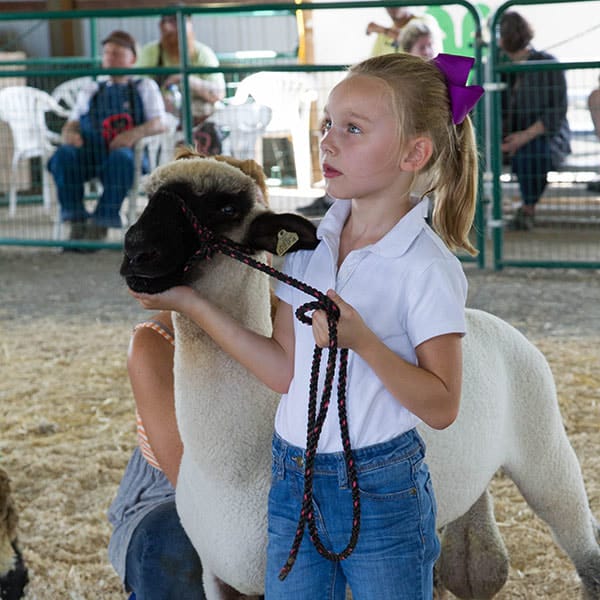
Part of your job when showing your lamb is to maintain good awareness of what is happening in the exhibition arena around you, including the judge’s position and the position of other showmen and animals in your class. Doing so will allow you to be prepared to brace your lamb so the judge gets the best impression of your animal when he gets to it in the ring, and you also will not miss directions, which can irritate a judge … particularly in a showmanship class. By maintaining ring awareness at a sheep show you can move around your animal to always present the judge with the best, unobstructed view of your show lamb.
Finally, maintaining good eye contact with the judge (and remembering to smile every once in a while) can draw his eye to your lamb and give him a more favorable impression of you and your sheep in the show ring.
Setting Up and Bracing Your Lamb
Once you have approval from the show officials to enter the ring for your class at the sheep show, one of the first things you’ll be asked to do is to line up for the judge and set up your sheep for his initial evaluation.
Every judge is a little different, so if you have the opportunity to watch a few classes before yours is called, do so. This will give you an idea of where he asks folks to set up their animals, how he asks them to walk around the ring, how he calls sheep out to place them in their class, etc. The judge may not be consistent every time, but most judges are, so if you have a general idea of when and where you’ll be moving and setting up your lamb during the class, this will give you an advantage.
Setting Up Your Lamb for Show
“Setting up” your sheep during a sheep show is a term which describes getting the sheep’s feet positioned squarely and naturally under it so that your show lamb appears balanced and looks its best. There’s no single correct position that applies to all sheep … some lambs look better more stretched out, and some look better with their feet set a bit wider in the rear. It’s a good idea to speak with your 4H leader, or an experienced showman at the fair for tips, and to practice setting your lamb up on your trimming stand while you’re preparing for the show so you (and your lamb) get used to getting its legs in position.
In general you want your sheep’s feet set squarely under the four corners of its body. For most lambs, the hocks on the sheep’s rear legs should be out an extra 1/2″ or so beyond the position where they would be totally vertical. The front legs should be square under the sheep’s shoulders, and the feet should be set a natural width from one another so they appear straight when viewed from the front or rear.
Your lamb’s head should be raised to a natural position, with its nose pointed forward. Your hand should be under the lamb’s chin, toward its neck, so that you can hold the lamb’s head high, but allow its nose to come down enough so its jaw can be level with its back.
There are regional differences in how sheep are set up and braced in the show ring. In New England, for example, many showmen will crouch beside their lamb and rub the belly of the lamb to keep the top-line straight for the judge, standing to brace the lamb when the judge approaches to handle the lamb. In the Midwest, many showmen stand and brace the lamb throughout the show. Your size, and the size of the sheep you are showing, will dictate the best position for you.
Bracing Your Lamb in the Show Ring
When you are showing your sheep, every judge will (on at least one occasion) approach your lamb to handle it, check its conditioning, length, thickness, and structure. Bracing your lamb properly can make your sheep handle better and give you a competitive advantage over your competitors. The ideal bracing position places your knee against the lamb’s brisket (chest), and provides some gentle pressure as the lamb’s head is held high. This encourages the lamb to push back against you, flexing its muscles to improve how it feels to the judge.
Bracing your lamb is something you should practice beforehand with a parent or friend. If your lamb spooks and jumps or moves about when handled, the judge won’t be able to accurately evaluate it, and pushing back against your knee without moving its feet from the “set up” position is a learned behavior.
The most experienced showmen can get any lamb to brace properly, but for beginners it’s important to practice. Aggressively pulling or twisting the sheep’s neck, or lifting your lamb off the ground in the show ring is not necessary, and it is not the way to properly brace a sheep in the show ring.
More Sheep Showing Tips
Beyond the basics of how to show sheep covered so far in this article, one final point which I feel should be stressed is that you should be respectful and have fun while exhibiting your lambs. This includes:
- Treat the show staff, judge, and exhibitors with respect and patience.
- Handle your sheep with patience and an even temper. Never handle your sheep in an aggressive way that could be misconstrued (remember, this is a public event and all eyes are on you!)
- Show good sportsmanship, no matter the outcome (stay in the ring to listen to the judge’s final comments and congratulate other exhibitors).
- Keep your area at the fair clean and orderly. This includes all feeding supplies and water buckets, trimming and tack, and any shared storage spaces for storing grain and hay at the fairgrounds. Cleanliness provides a good public image for all sheep farmers, and it’s safer to not have shears and other equipment out in the open when not in use.
Showing sheep is a fun culmination of all of your hard work on the farm – work that goes without acknowledgement or congratulations. See each sheep show as an opportunity to be an ambassador for farming and raising sheep, and enjoy the friendships and company that come when you spend time exhibiting your flock alongside other shepherds with whom you share a common interest.

